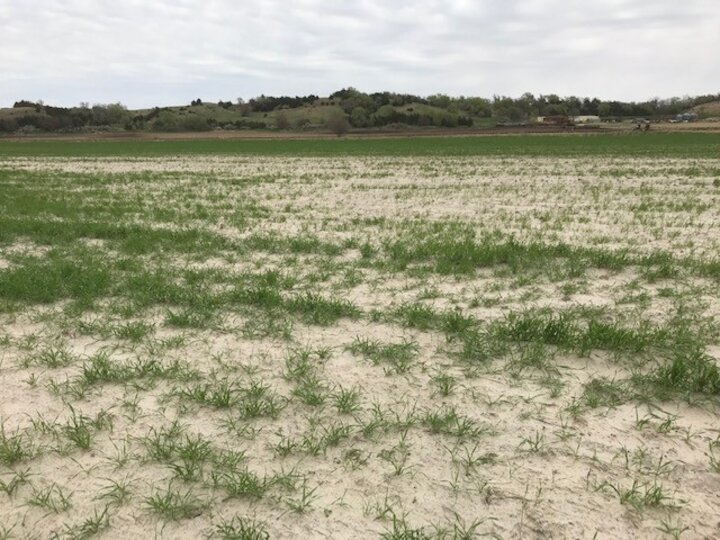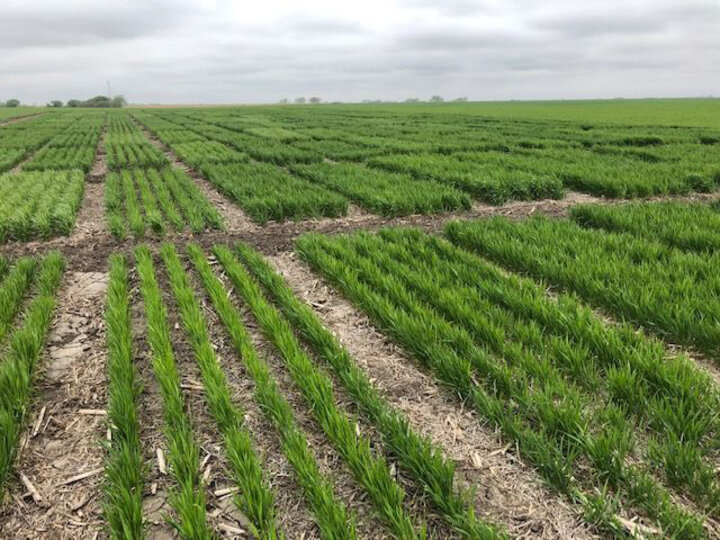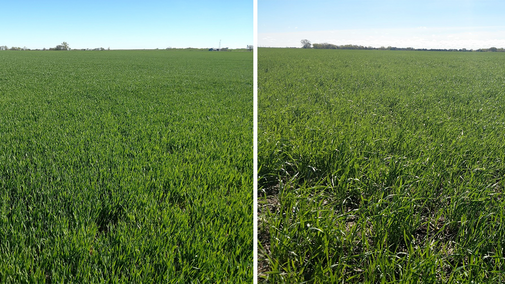
Wheat in eastern Nebraska makes up about 5% of the state's total wheat acres but is the third most planted annual crop after corn and soybean. Delayed planting and a cool spring have put the crop behind in maturity, though progress is similar to last year. Good yield potentials remain due to good soil moisture, decent stands and spring tillering, and a forecast for cool to normal temperatures the first half of the summer.
Northeast and East Central Nebraska
Wheat grown in these districts (Figure 2) make up about 20% of the eastern Nebraska wheat acres. Planting last fall included a narrow window at the beginning of October with wetter than ideal soil conditions, followed by a larger planting window from October 20 through the end of October. Fall tillering did not occur in wheat planted near the end of October. Growers who increased their seeding rate in late October have good plant populations (over 1 million plants per acre) that will help compensate for a lack of fall tillering. A multi-year study done by K-State near Colby, Kansas has shown that increasing the seeding rate when planting at a later than optimal planting date will help maintain yields.


Minor winterkill was observed this year in low residue areas, on tilled ground, and in shallow-planted spots within fields. In a few instances, late-planted fields have been abandoned or sprayed out due to a combination of winterkill, ponded water/ice, and erosion/deposition from flooding (Figure 3).
Currently, growth stages of fields checked in Boone, Butler, Colfax, Dodge, Nance, Platte, Stanton, and Washington counties range from mid tillering (Feekes 3) to jointing (Feekes 6), with most at Feekes 4-5, which is similar to last year (Figure 4). Growers were encouraged to spring top-dress their wheat early to promote spring tillering on late-planted fields. Spring tillering this past month has been good with plants likely to produce three to four heads. Herbicide application for winter annual weeds and early emerging summer annuals is on the to-do-list before wheat reaches jointing (Feekes 6) if 2,4-D or Dicamba is to be included. Other herbicides, like Affinity Broadspec and Huskie, have more flexibility and can be safely applied after jointing. Growers do need to be aware of crop/cover crop rotation restrictions with some wheat herbicides, so do your homework and read labels.


Wheat was significantly shorter than normal during the last growing season, and the expectation is the same for this year. We know from past experience that late-planted wheat is likely going to be shorter. Lack of soil moisture has not been a limiting factor in east-central and northeast Nebraska this spring, unlike some areas a year ago. Disease pressure was low this spring for fungal leaf spots. However, we will need to watch the movement of stripe and leaf rust, documented in Kansas last week. The cool wet spring has been a favorable environment for wheat soilborne mosaic virus, so be sure to monitor fields for symptoms, especially on susceptible varieties. Some yellowing of wheat plants has been due to nitrogen or sulfur deficiencies (Figure 5).
Southeast Nebraska
Wheat grown in the southeast district (Figure 1) makes up about 80% of the eastern Nebraska wheat acres. The wheat yield potential in southeast Nebraska is generally very good despite late planting caused by wet weather last fall during soybean harvest. A lot of wheat this year was planted on or after October 15. Some, like the UNL variety trial (Figure 6), were planted earlier. According to the National Agricultural Statistics Service, Jefferson County harvested 5390 acres of winter wheat in 2018 and Saline County hit a low of 2,460 acres. In southwest region (Clay, Fillmore, Nuckolls, Thayer) where most of the wheat in eastern Nebraska is grown, the current growth stage of wheat ranges from late tillering (Feekes 4-5) to jointing (Feekes 6). The range in growth stages was due to last year’s wet harvest conditions (Figure 1), which delayed the planting of some wheat fields.
On average five tillers have been observed in the checked fields with a range of three to six tillers. The spring weather caused ponding in field areas with poorly draining soil and plant loss was observed. In fields with poor wheat stands, oats or a similar crop can be seeded in bare areas for use as a forage or the field could be terminated and planted to corn. Minor frost injury was observed in a few fields in Clay and Nuckolls counties. Neither leaf stripe nor rust has been observed in any of the checked fields. Wheat has begun to joint or reach the Feekes 6 growth stage, so driving on it will cause damage. Some producers in the area that have shown interest in late nitrogen applications to enhance protein premium are going after the milling market incentives.
With a beginning full profile of moisture, ultimately the yield outcome will depend a lot on our weather including temperatures the end of May and into June during the critical grain fill period. Lack of soil moisture has only been a minor problem in southeast Nebraska for dissolving and moving nitrogen fertilizer into the rooting zone. However, the soil moisture situation is much improved from a year ago.
Just remember that including wheat in your production provides an opportunity for summer conservation work, manure application, and planting of sunflowers or cover crops. Many producers have dramatically changed how they manage a field after wheat harvest until a spring crop is planted. They have shifted away from using tillage and chemical weed control in wheat stubble (summer fallow) to planting a no-till cover crop or double (forage/hay) crop to increase soil health or increase income potential.
Upcoming Wheat Field Days in Eastern Nebraska
UNL Wheat Variety Tour, Jefferson County — Thursday, June 13 at 6:30 p.m. Contact Randy Pryor for more information (Figure 6).
Wheat and Pulse Crop Field Day, Eastern Nebraska Research and Extension Center (ENREC) near Mead — Tuesday, June 18 from 9 a.m. to 4 p.m. Contact Nathan Mueller for more information or visit http://croptechcafe.org/winterwheat/

